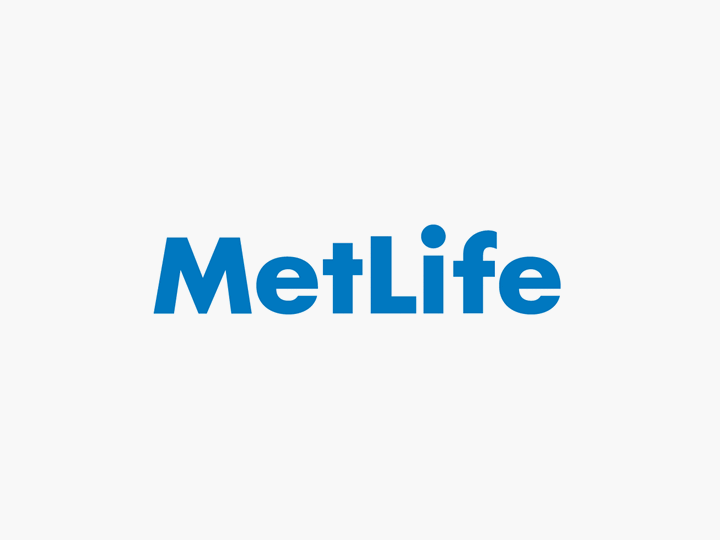Attached files
| file | filename |
|---|---|
| 8-K - FORM 8-K - METLIFE INC | y93702e8vk.htm |
| EX-99.2 - EX-99.2 - METLIFE INC | y93702exv99w2.htm |

| INVESTOR PRESENTATION 2 0 1 1 Agenda |

| These materials may contain or incorporate by reference information that includes or is based upon forward-looking statements within the meaning of the Private Securities Litigation Reform Act of 1995. Forward-looking statements give expectations or forecasts of future events. These statements can be identified by the fact that they do not relate strictly to historical or current facts. They use words such as "anticipate," "estimate," "expect," "project," "intend," "plan," "believe" and other words and terms of similar meaning in connection with a discussion of future operating or financial performance. In particular, these include statements relating to future actions, prospective services or products, future performance or results of current and anticipated services or products, sales efforts, expenses, the outcome of contingencies such as legal proceedings, trends in operations and financial results. Any or all forward-looking statements may turn out to be wrong. They can be affected by inaccurate assumptions or by known or unknown risks and uncertainties. Many such factors will be important in determining the actual future results of MetLife, Inc., its subsidiaries and affiliates. These statements are based on current expectations and the current economic environment. They involve a number of risks and uncertainties that are difficult to predict. These statements are not guarantees of future performance. Actual results could differ materially from those expressed or implied in the forward-looking statements. Risks, uncertainties, and other factors that might cause such differences include the risks, uncertainties and other factors identified in MetLife, Inc.'s filings with the U.S. Securities and Exchange Commission (the "SEC"). These factors include: (1) difficult conditions in the global capital markets; (2) concerns over U.S. fiscal policy and the trajectory of the national debt of the U.S., as well as rating agency downgrades of U.S. Treasury securities; (3) increased volatility and disruption of the capital and credit markets, which may affect our ability to seek financing or access our credit facilities; (4) uncertainty about the effectiveness of the U.S. government's programs to stabilize the financial system, the imposition of fees relating thereto, or the promulgation of additional regulations; (5) impact of comprehensive financial services regulation reform on us; (6) exposure to financial and capital market risk; (7) changes in general economic conditions, including the performance of financial markets and interest rates, which may affect our ability to raise capital, generate fee income and market-related revenue and finance statutory reserve requirements and may require us to pledge collateral or make payments related to declines in value of specified assets; (8) potential liquidity and other risks resulting from our participation in a securities lending program and other transactions; (9) investment losses and defaults, and changes to investment valuations; (10) impairments of goodwill and realized losses or market value impairments to illiquid assets; (11) defaults on our mortgage loans; (12) the impairment of other financial institutions that could adversely affect our investments or business; (13) our ability to address unforeseen liabilities, asset impairments, loss of key contractual relationships, or rating actions arising from acquisitions or dispositions, including our acquisition of American Life Insurance Company and Delaware American Life Insurance Company (collectively, "ALICO") and to successfully integrate and manage the growth of acquired businesses with minimal disruption; (14) uncertainty with respect to the outcome of the closing agreement entered into with the United States Internal Revenue Service in connection with the acquisition of ALICO; (15) the dilutive impact on our stockholders resulting from the issuance of equity securities in connection with the acquisition of ALICO or otherwise; (16) economic, political, currency and other risks relating to our international operations, including with respect to fluctuations of exchange rates; (17) our primary reliance, as a holding company, on dividends from our subsidiaries to meet debt payment obligations and the applicable regulatory restrictions on the ability of the subsidiaries to pay such dividends; (18) downgrades in our claims paying ability, financial strength or credit ratings; (19) ineffectiveness of risk management policies and procedures; (20) availability and effectiveness of reinsurance or indemnification arrangements, as well as default or failure of counterparties to perform; (21) discrepancies between actual claims experience and assumptions used in setting prices for our products and establishing the liabilities for our obligations for future policy benefits and claims; (22) catastrophe losses; (23) heightened competition, including with respect to pricing, entry of new competitors, consolidation of distributors, the development of new products by new and existing competitors, distribution of amounts available under U.S. government programs, and for personnel; (24) unanticipated changes in industry trends; (25) changes in accounting standards, practices and/or policies; (26) changes in assumptions related to deferred policy acquisition costs, deferred sales inducements, value of business acquired or goodwill; (27) increased expenses relating to pension and postretirement benefit plans, as well as health care and other employee benefits; (28) exposure to losses related to variable annuity guarantee benefits, including from significant and sustained downturns or extreme volatility in equity markets, reduced interest rates, unanticipated policyholder behavior, mortality or longevity, and the adjustment for nonperformance risk; (29) deterioration in the experience of the "closed block" established in connection with the reorganization of Metropolitan Life Insurance Company; (30) adverse results or other consequences from litigation, arbitration or regulatory investigations; (31) inability to protect our intellectual property rights or claims of infringement of the intellectual property rights of others; (32) discrepancies between actual experience and assumptions used in establishing liabilities related to other contingencies or obligations; (33) regulatory, legislative or tax changes relating to our insurance, banking, international, or other operations that may affect the cost of, or demand for, our products or services, impair our ability to attract and retain talented and experienced management and other employees, or increase the cost or administrative burdens of providing benefits to employees; (34) the effects of business disruption or economic contraction due to disasters such as terrorist attacks, cyberattacks, other hostilities, or natural catastrophes, including any related impact on our disaster recovery systems, cyber-or other information security systems and management continuity planning; (35) the effectiveness of our programs and practices in avoiding giving our associates incentives to take excessive risks; and (36) other risks and uncertainties described from time to time in MetLife, Inc.'s filings with the SEC. MetLife, Inc. does not undertake any obligation to publicly correct or update any forward-looking statement if MetLife, Inc. later becomes aware that such statement is not likely to be achieved. Please consult any further disclosures MetLife, Inc. makes on related subjects in reports to the SEC. Safe Harbor Statement 2 |

| Explanatory Note on Non-GAAP Financial Information All references in this presentation to net income (loss), net income (loss) per share, operating earnings, operating earnings per share and book value per share should be read as net income (loss) available to MetLife, Inc.'s common shareholders, net income (loss) available to MetLife, Inc.'s common shareholders per diluted common share, operating earnings available to common shareholders, operating earnings available to common shareholders per diluted common share and book value per common share, respectively. Operating earnings is the measure of segment profit or loss that MetLife uses to evaluate segment performance and allocate resources and, consistent with accounting principles generally accepted in the United States of America ("GAAP") accounting guidance for segment reporting, is MetLife's measure of segment performance. Operating earnings is also a measure by which MetLife senior management's and many other employees' performance is evaluated for the purposes of determining their compensation under applicable compensation plans. Operating earnings is defined as operating revenues less operating expenses, both net of income tax. Operating earnings available to common shareholders is defined as operating earnings less preferred stock dividends. Operating revenues exclude net investment gains (losses) and net derivative gains (losses). The following additional adjustments are made to GAAP revenues, in the line items indicated, in calculating operating revenues: Universal life and investment-type product policy fees exclude the amortization of unearned revenue related to net investment gains (losses) and net derivative gains (losses) and certain variable annuity guaranteed minimum income benefits ("GMIB") fees ("GMIB Fees"); Net investment income: (i) includes amounts for scheduled periodic settlement payments and amortization of premium on derivatives that are hedges of investments but do not qualify for hedge accounting treatment, (ii) includes income from discontinued real estate operations, (iii) excludes certain amounts related to contractholder-directed unit-linked investments, (iv) excludes post-tax operating earnings adjustments relating to insurance joint ventures accounted for under the equity method, and (v) excludes certain amounts related to securitization entities that are variable interest entities ("VIEs") consolidated under GAAP; and Other revenues are adjusted for settlements of foreign currency earnings hedges. 3 The following adjustments are made to GAAP expenses, in the line items indicated, in calculating operating expenses: Policyholder benefits and claims and policyholder dividends exclude: (i) changes in the policyholder dividend obligation related to net investment gains (losses) and net derivative gains (losses), (ii) inflation-indexed benefit adjustments associated with contracts backed by inflation-indexed investments and amounts associated with periodic crediting rate adjustments based on the total return of a contractually referenced pool of assets, (iii) benefits and hedging costs related to GMIBs ("GMIB Costs"), and (iv) market value adjustments associated with surrenders or terminations of contracts ("Market Value Adjustments"); Interest credited to policyholder account balances includes adjustments for scheduled periodic settlement payments and amortization of premium on derivatives that are hedges of policyholder account balances but do not qualify for hedge accounting treatment and excludes amounts related to net investment income earned on contractholder-directed unit-linked investments; Amortization of DAC and value of business acquired ("VOBA") excludes amounts related to: (i) net investment gains (losses) and net derivative gains (losses), (ii) GMIB Fees and GMIB Costs, and (iii) Market Value Adjustments; Amortization of negative VOBA excludes amounts related to Market Value Adjustments; Interest expense on debt excludes certain amounts related to securitization entities that are VIEs consolidated under GAAP; and Other expenses exclude costs related to: (i) noncontrolling interests, (ii) implementation of new insurance regulatory requirements, and (iii) business combinations. |
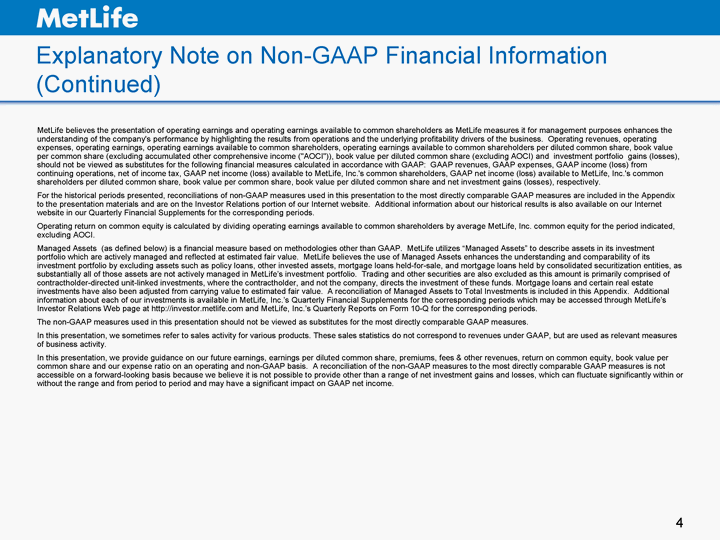
| Explanatory Note on Non-GAAP Financial Information (Continued) MetLife believes the presentation of operating earnings and operating earnings available to common shareholders as MetLife measures it for management purposes enhances the understanding of the company's performance by highlighting the results from operations and the underlying profitability drivers of the business. Operating revenues, operating expenses, operating earnings, operating earnings available to common shareholders, operating earnings available to common shareholders per diluted common share, book value per common share (excluding accumulated other comprehensive income ("AOCI")), book value per diluted common share (excluding AOCI) and investment portfolio gains (losses), should not be viewed as substitutes for the following financial measures calculated in accordance with GAAP: GAAP revenues, GAAP expenses, GAAP income (loss) from continuing operations, net of income tax, GAAP net income (loss) available to MetLife, Inc.'s common shareholders, GAAP net income (loss) available to MetLife, Inc.'s common shareholders per diluted common share, book value per common share, book value per diluted common share and net investment gains (losses), respectively. For the historical periods presented, reconciliations of non-GAAP measures used in this presentation to the most directly comparable GAAP measures are included in the Appendix to the presentation materials and are on the Investor Relations portion of our Internet website. Additional information about our historical results is also available on our Internet website in our Quarterly Financial Supplements for the corresponding periods. Operating return on common equity is calculated by dividing operating earnings available to common shareholders by average MetLife, Inc. common equity for the period indicated, excluding AOCI. Managed Assets (as defined below) is a financial measure based on methodologies other than GAAP. MetLife utilizes "Managed Assets" to describe assets in its investment portfolio which are actively managed and reflected at estimated fair value. MetLife believes the use of Managed Assets enhances the understanding and comparability of its investment portfolio by excluding assets such as policy loans, other invested assets, mortgage loans held-for-sale, and mortgage loans held by consolidated securitization entities, as substantially all of those assets are not actively managed in MetLife's investment portfolio. Trading and other securities are also excluded as this amount is primarily comprised of contractholder-directed unit-linked investments, where the contractholder, and not the company, directs the investment of these funds. Mortgage loans and certain real estate investments have also been adjusted from carrying value to estimated fair value. A reconciliation of Managed Assets to Total Investments is included in this Appendix. Additional information about each of our investments is available in MetLife, Inc.'s Quarterly Financial Supplements for the corresponding periods which may be accessed through MetLife's Investor Relations Web page at http://investor.metlife.com and MetLife, Inc.'s Quarterly Reports on Form 10-Q for the corresponding periods. The non-GAAP measures used in this presentation should not be viewed as substitutes for the most directly comparable GAAP measures. In this presentation, we sometimes refer to sales activity for various products. These sales statistics do not correspond to revenues under GAAP, but are used as relevant measures of business activity. In this presentation, we provide guidance on our future earnings, earnings per diluted common share, premiums, fees & other revenues, return on common equity, book value per common share and our expense ratio on an operating and non-GAAP basis. A reconciliation of the non-GAAP measures to the most directly comparable GAAP measures is not accessible on a forward-looking basis because we believe it is not possible to provide other than a range of net investment gains and losses, which can fluctuate significantly within or without the range and from period to period and may have a significant impact on GAAP net income. 4 |

| Agenda Overview Overview Overview Steven A. Kandarian President & Chief Executive Officer Investments Investments Investments Steven J. Goulart Executive Vice President & Chief Investment Officer Finance Finance Finance William J. Wheeler President of the Americas Q&A Q&A Q&A Appendix Appendix Appendix 5 |
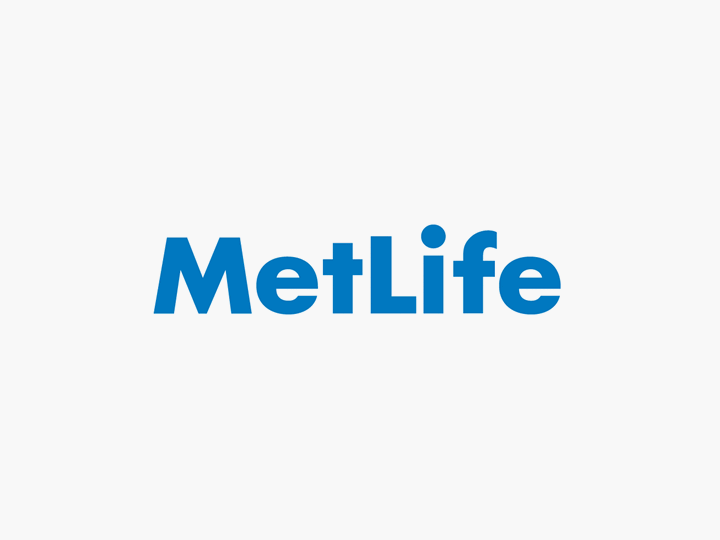
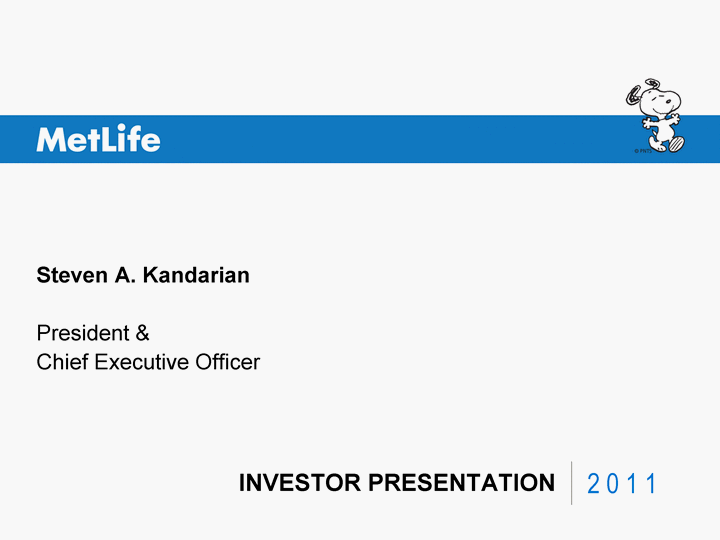
| INVESTOR PRESENTATION 2 0 1 1 Steven A. Kandarian President & Chief Executive Officer |

| 2 Positioned to Deliver Shareholder Value Global Presence Leadership positions in large established markets Strong and growing presence in high growth markets with favorable demographics and high margins Brand Well established and expanding brand to drive preference for our products Diversified Products & Distribution Broad and diverse products and distribution channels to meet customer needs worldwide Financial Strength Solid balance sheet and strong risk management Strong capital generation |

| 3 Leadership Positions in Markets of Today & Tomorrow Established Significant & Growing Emerging Global Life Insurance Markets United States Japan Mexico Korea Poland Chile Russia Brazil China India Turkey High Margins and Attractive Growth Prospects Largest Global Markets with Strong Cash Generation Fast Growing and Good Margins |

| 4 MetLife Brand Drives Customer Preference Japan Increased "purchase consideration" from 20.6% to 28.6% (pre vs. post acquisition) "Snoopy J" has been seen personally by 10% of consumers Poland New advertising campaign increased brand awareness from 3% to 34% Russia First American company to sponsor Bolshoi Theatre in its 235-year history USA MetLife Stadium announcement generated over 1 billion media impressions during first eight days To date, has generated approximately $13 million in equivalent media value |

| 5 Broad and diverse distribution platform Face-to-face Bancassurance Broker Direct Worldwide distribution expertise Driving toward a customer centric organization Customers Do Business with MetLife Through Multiple Distribution Channels |
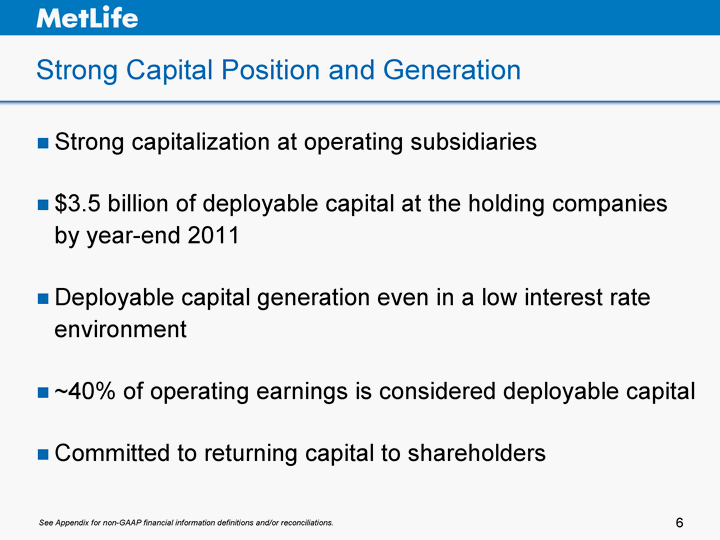
| 6 Strong capitalization at operating subsidiaries $3.5 billion of deployable capital at the holding companies by year-end 2011 Deployable capital generation even in a low interest rate environment ~40% of operating earnings is considered deployable capital Committed to returning capital to shareholders Strong Capital Position and Generation See Appendix for non-GAAP financial information definitions and/or reconciliations. |

| 7 Proactive actions to protect earnings If Treasury rates remain low for 5 years earnings still grow 4% versus 8%2 Well Positioned for Low Interest Rate Environment 1For illustrative purposes only. 2This hypothetical scenario assumes U.S. Business and International & Other annual growth rates of 6% and 10%, respectively. See Appendix for non-GAAP financial information definitions and/or reconciliations. Operating Earnings Scenario1 ($0.5) ($0.7) ($ Billions) |
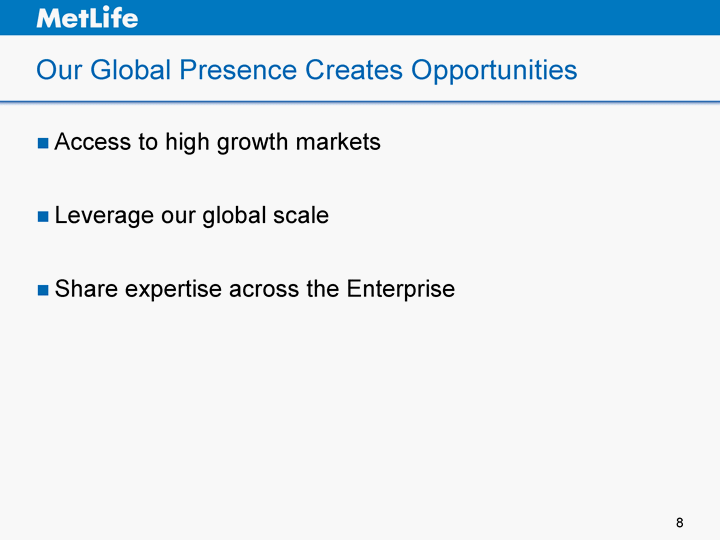
| 8 Access to high growth markets Leverage our global scale Share expertise across the Enterprise Our Global Presence Creates Opportunities |
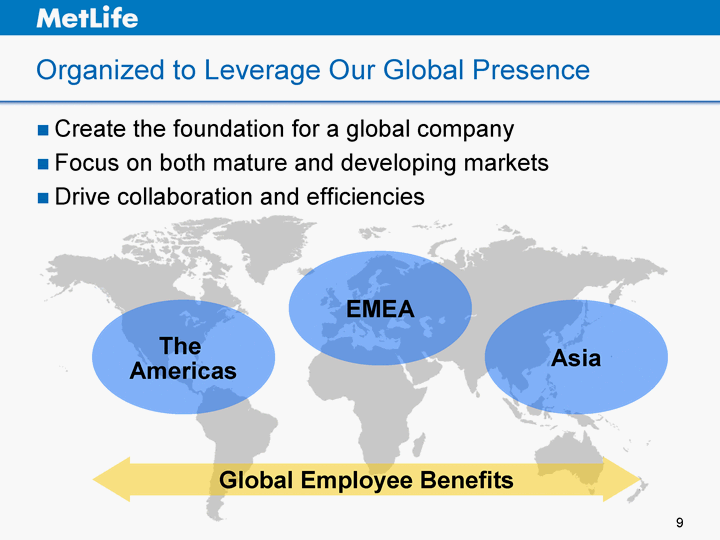
| 9 Organized to Leverage Our Global Presence Asia Global Employee Benefits EMEA The Americas Create the foundation for a global company Focus on both mature and developing markets Drive collaboration and efficiencies |

| 10 MetLife is the leader in employee benefits for large employers in the United States We have a unique global footprint Opportunity to serve ~40 million employees outside of the U.S.2 Building a Global Employee Benefits Franchise Source: Fortune, MetLife, Dunn & Bradstreet, Annual reports, McKinsey analysis. 2International lives may vary due to employer coverage across countries. MetLife International has approximately 520,000 employees as clients in its heritage Alico portfolio. 62 Million employees worldwide (2010) Employees of Large Companies1 40 million employees outside of the U.S.2 22 million employees in the U.S. 1Includes 864 companies in the 2010 U.S. Fortune 500 and Global 500 lists; 136 U.S. companies also present in the Global 500 list. |
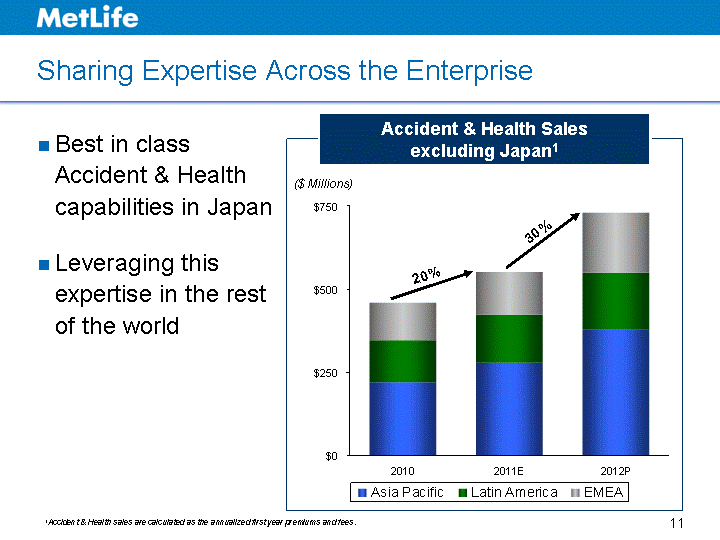
| 11 Sharing Expertise Across the Enterprise Best in class Accident & Health capabilities in Japan Leveraging this expertise in the rest of the world Accident & Health Sales excluding Japan1 30% 20% 1Accident & Health sales are calculated as the annualized first year premiums and fees. ($ Millions) |

| 12 Take a portfolio view of our businesses Continuously assess our strategy Balance growth, profitability and risk Optimize the use of capital Guiding Principles for Building on Our Strengths |
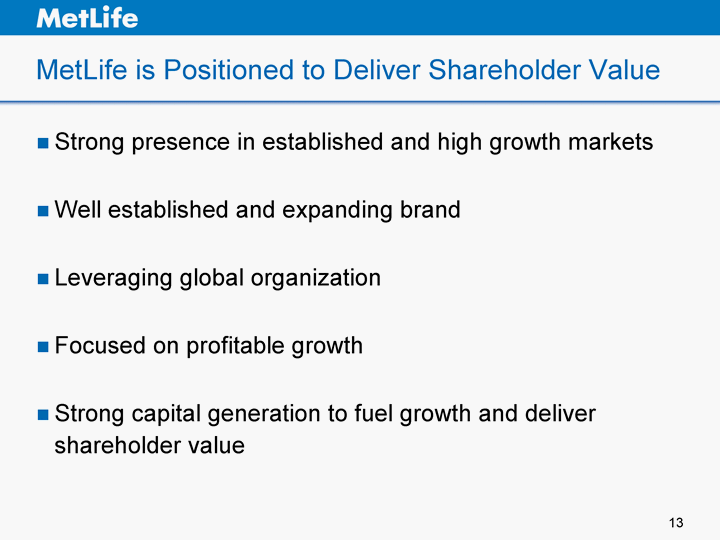
| 13 Strong presence in established and high growth markets Well established and expanding brand Leveraging global organization Focused on profitable growth Strong capital generation to fuel growth and deliver shareholder value MetLife is Positioned to Deliver Shareholder Value |
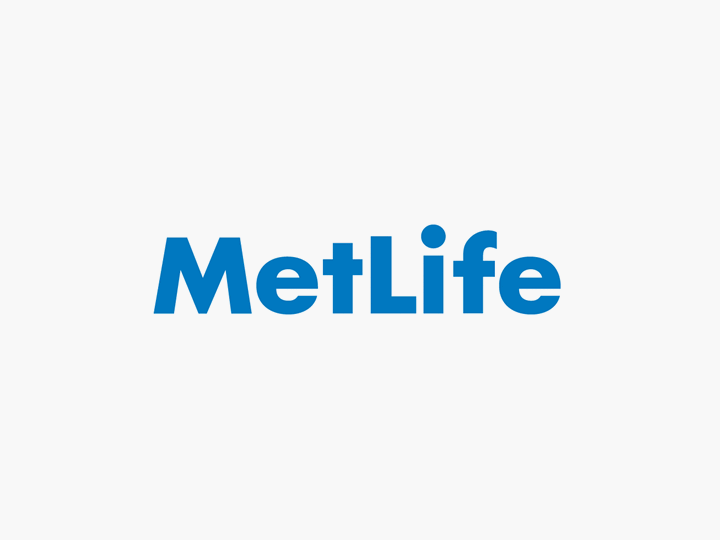

| INVESTOR PRESENTATION 2 0 1 1 Steven J. Goulart Executive Vice President & Chief Investment Officer |

| 2 Agenda Current environment Portfolio highlights Summary |

| 3 Global Macro Environment Europe Americas Japan Latin America U.S. Asia EMEA Asia (Ex-Japan) Low growth, fiscal policy risks, managed rates Low growth, deflation, strong yen Cooling growth, inflation, commodity risk Cooling growth, inflation, sound fiscal policy Recession risk, fiscal union, monetary easing |

| Investments Global Reach Investments headquartered in Morristown, New Jersey Regional offices in London, Tokyo, Hong Kong and Santiago Global team approach - 750+ person team Bangalore Sydney Hong Kong Hong Kong Taipei Shanghai Beijing Seoul Tokyo Morristown Hong Kong Santiago London 4 |
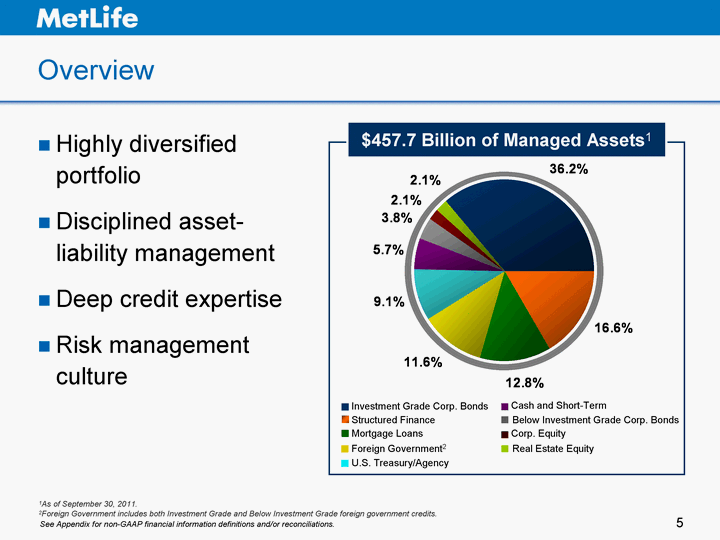
| 5 Overview Highly diversified portfolio Disciplined asset- liability management Deep credit expertise Risk management culture Inv Grade Corp Bonds Structured Finance Mortgage Loans Foreign Government U.S. Treasury/Agency Cash & Short-Term Below Inv Grade Credit Corp Equity RE Equity East 36.2 16.6 12.8 11.6 9.1 5.7 3.8 2.1 2.1 Investment Grade Corp. Bonds Structured Finance Mortgage Loans Foreign Government2 U.S. Treasury/Agency Cash and Short-Term Below Investment Grade Corp. Bonds Corp. Equity Real Estate Equity 1As of September 30, 2011. 2Foreign Government includes both Investment Grade and Below Investment Grade foreign government credits. $457.7 Billion of Managed Assets1 See Appendix for non-GAAP financial information definitions and/or reconciliations. |

| 6 URL FY 2010 YTD 9/30/2011 12/31/2008 3/31/2009 6/30/2009 9/30/2009 12/31/2009 9/30/2010 Gross Gains 1.2 1.115 782 571 263 327 288 212 Gross Losses & Impairments -1.393 -1.199 -1283 -1576 -1392 -1072 -501 -313 Net Realized Gains/(Losses) -0.2 -0.084 -501 -1005 -1129 -745 -213 -101 URL 12/31/2010 9/30/2011 Gross Gains 14 25.3 Net URG/(L) 7.2 19.8 Gross Losses -6.8 -5.5 6 Low Net Realized Losses1 Gross Gains Gross Losses ($ Billions) Unrealized ($0.2) $7.2 $19.8 Net Gains (Losses) ($0.1) 12/31/2010 9/30/2011 ($ Billions) Realized 1Pre-tax investment portfolio gains (losses). See Appendix for non-GAAP financial information definitions and/or reconciliations. |

| 7 High Quality Fixed Income Securities Portfolio 91% investment grade Top down and bottom up fundamental credit selection U.S. Corporate Securities Foreign Corporate Securities Foreign Government Securities State and Political Subdivision Other Fixed Maturity Securities East 106575 63522 52959 13141 1 $236.2 Billion Portfolio1 1Estimated fair value as of September 30, 2011; excludes structured securities. U.S. Corporate Securities Foreign Government Securities State and Political Subdivision Foreign Corporate Securities |

| 8 Declining European Bank Exposure 12/31/2010 9/30/2011 Non-Peripherals 8396 6376 Peripherals 883 481 U.S. GAAP Book Value $9,279 $6,857 Country of Domicile ($ Millions) 1Spain, Ireland, Portugal, Italy and Greece. 1 $8,396 $883 $6,376 $481 |
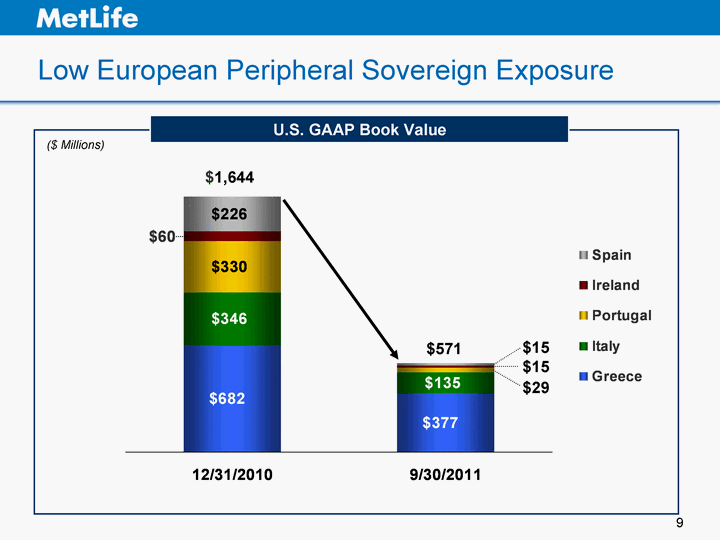
| 9 Low European Peripheral Sovereign Exposure U.S. GAAP Book Value 12/31/2010 9/30/2011 Greece 682 377 Italy 346 135 Portugal 330 29 Ireland 60 15 Spain 226 15 $1,644 $571 $15 ($ Millions) $29 $15 |

| 10 High Quality Structured Finance Portfolio 95% of combined portfolio is investment grade Collateral characteristics and tranche selection are critical ABS: $14.4B2 CMBS: $19.6B2 RMBS: $41.9B2 $75.9 Billion Portfolio1 Investment Grade Below Investment Grade 1Estimated fair value as of September 30, 2011. 2Amounts presented for structured securities held by subsidiaries that file NAIC statutory financial statements are based on revised NAIC methodologies and interim internal ratings for securities not yet evaluated by the NAIC, which may not correspond to rating agency designations. |

| 11 Competitive Advantage in Private Assets Real Estate Investments Agricultural Mortgages Private Corporates |

| 12 Real Estate and Agricultural Investments 17 regional offices; 200+ person team Focus on Class 'A' properties in primary markets Agricultural mortgages diversified by geography and sector Adequately Positioned Commercial Loans 41.5 Agricultural Mortgage Loans 13.4 Real Estate Equity 9.8 Residential Mortgage Loans 3.5 Commercial Mortgages Agricultural Mortgages $68.2 Billion Portfolio1 1Estimated fair value as of September 30, 2011. Real Estate Equity Residential Mortgages |
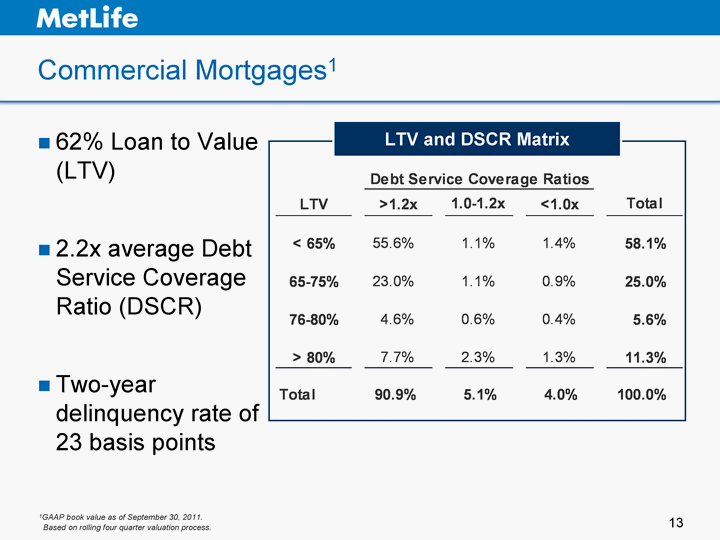
| 13 Commercial Mortgages1 62% Loan to Value (LTV) 2.2x average Debt Service Coverage Ratio (DSCR) Two-year delinquency rate of 23 basis points LTV and DSCR Matrix Based on rolling four quarter valuation process. 1GAAP book value as of September 30, 2011. |

| 14 Agricultural Mortgages1 48% Loan to Value (LTV) Sector and geography diversification reduces risk LTV Matrix 1GAAP book value as of September 30, 2011. |

| 15 Private Securities MetLife is a leading private placement investor Good downside protection via covenants and/or collateral Spread premium and lower losses versus public corporate bonds Adequately Positioned Private Corp. US 0.53 Private Corp. Non-US 0.35 Project Finance 0.05 Leasing and Tax Products 0.07 Project Finance Lease Equity U.S. Private Corp. Securities Foreign Private Corp. Securities $50.8 Billion Portfolio1 1Estimated fair value as of September 30, 2011. |
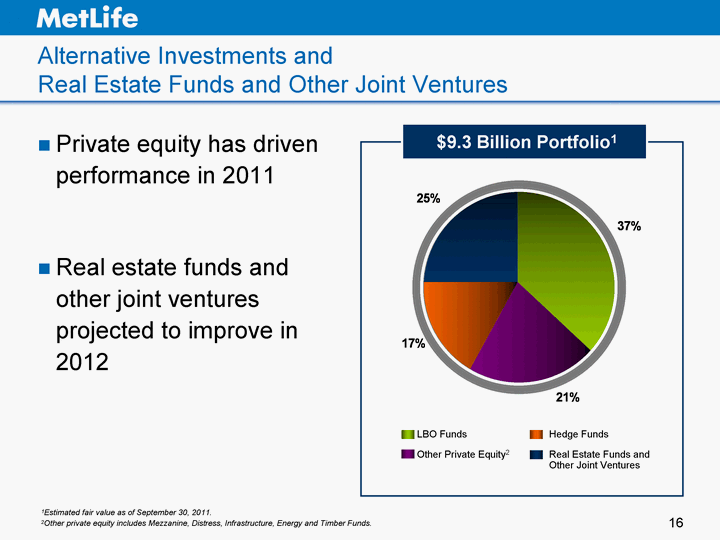
| 16 Alternative Investments and Real Estate Funds and Other Joint Ventures Private equity has driven performance in 2011 Real estate funds and other joint ventures projected to improve in 2012 $9.3 Billion Portfolio1 Hedge Funds Real Estate Funds and Other Joint Ventures LBO Funds Other Private Equity2 2Other private equity includes Mezzanine, Distress, Infrastructure, Energy and Timber Funds. 1Estimated fair value as of September 30, 2011. |
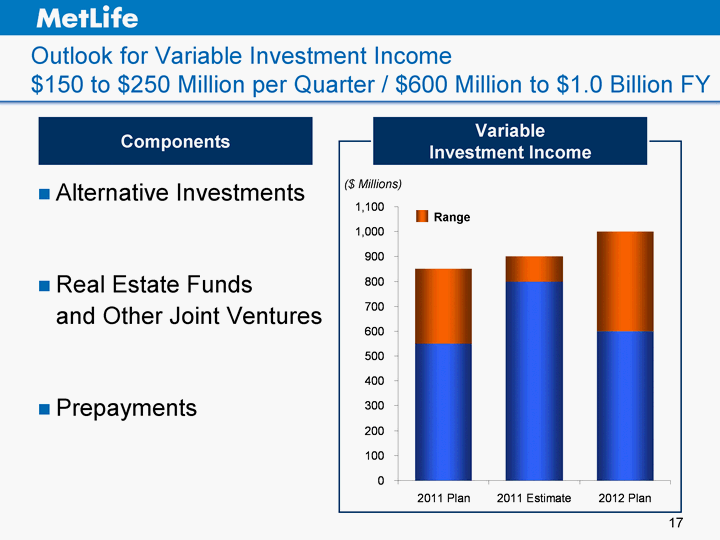
| 17 Outlook for Variable Investment Income $150 to $250 Million per Quarter / $600 Million to $1.0 Billion FY Alternative Investments Real Estate Funds and Other Joint Ventures Prepayments ($ Millions) Range Variable Investment Income Components |

| 18 Meaningful Low Rate Protection Approximately $47 billion notional2 to hedge against low rates Protection extending into next decade ($ Millions) Pre-Tax Derivative Income1 (+/-100bps Sensitivity) Total Derivatives (Swaps, Floors, Swaptions) +100bps - 100bps Flat 1Estimated based on August 31, 2011 rates, assuming parallel curve shift. 2MetLife investment portfolio (excluding International and Variable Annuity hedging programs and MetLife Bank) as of August 31, 2011. |

| 19 Summary Disciplined approach to investing and asset-liability management Meaningful reduction of European exposures Unique ability to source private assets Portfolio remains healthy and well positioned |

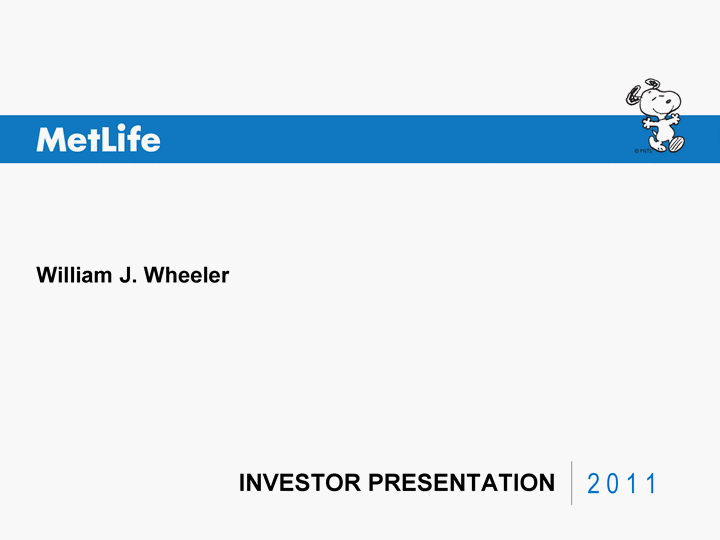
| INVESTOR PRESENTATION 2 0 1 1 William J. Wheeler |

| 2 Agenda Review of estimated results 4th Quarter 2011 2011 estimated results MetLife's capital position Review of 2012 plan |
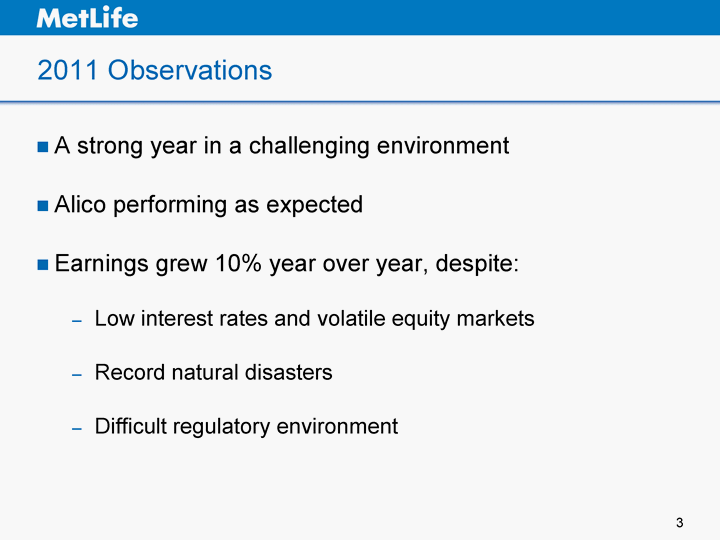
| 3 2011 Observations A strong year in a challenging environment Alico performing as expected Earnings grew 10% year over year, despite: Low interest rates and volatile equity markets Record natural disasters Difficult regulatory environment |

| Fourth Quarter 2011 Estimate 4 See Appendix for non-GAAP financial information definitions and/or reconciliations. ($ Millions, except per share data) |
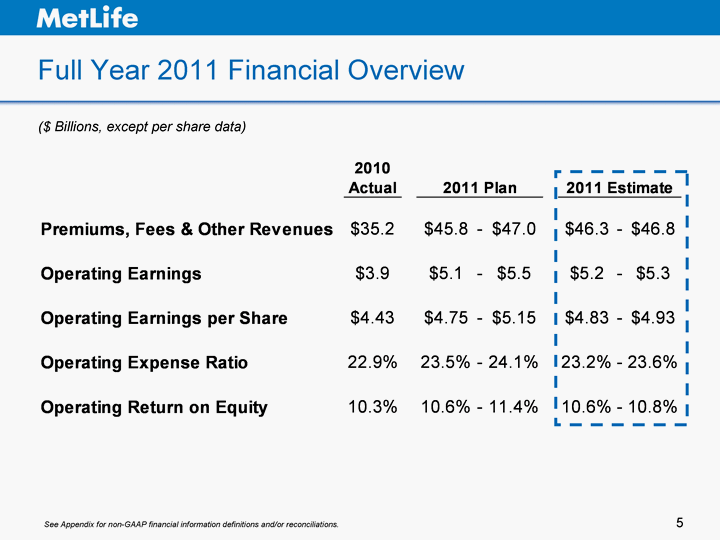
| 5 Full Year 2011 Financial Overview See Appendix for non-GAAP financial information definitions and/or reconciliations. ($ Billions, except per share data) |
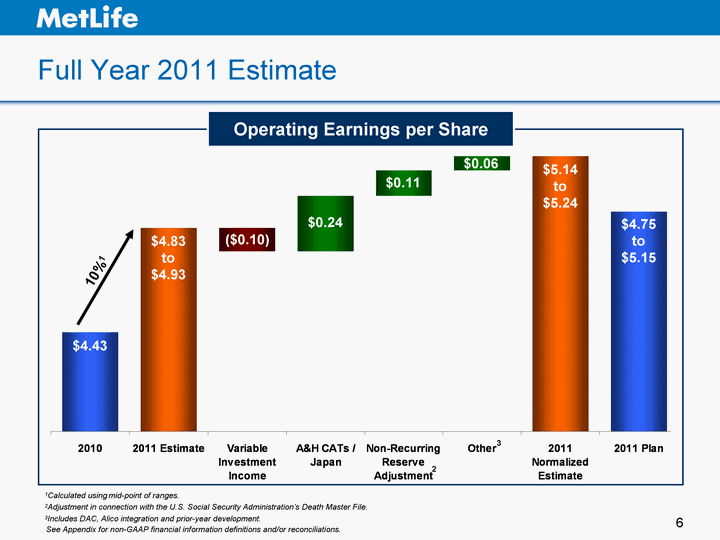
| 6 Full Year 2011 Estimate Operating Earnings per Share $4.43 $4.75 to $5.15 ($0.10) $4.83 to $4.93 $0.24 $0.11 $0.06 $5.14 to $5.24 10%1 1Calculated using mid-point of ranges. 2Adjustment in connection with the U.S. Social Security Administration's Death Master File. 3Includes DAC, Alico integration and prior-year development. See Appendix for non-GAAP financial information definitions and/or reconciliations. 3 2 |
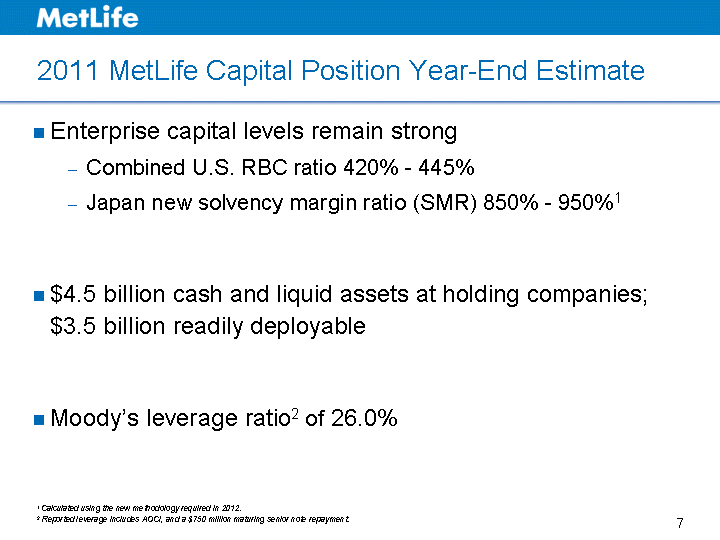
| 1 2011 MetLife Capital Position Year-End Estimate Enterprise capital levels remain strong Combined U.S. RBC ratio 420% - 445% Japan new solvency margin ratio (SMR) 850% - 950%1 $4.5 billion cash and liquid assets at holding companies; $3.5 billion readily deployable Moody's leverage ratio2 of 26.0% 1 Calculated using the new methodology required in 2012. 2 Reported leverage includes AOCI, and a $750 million maturing senior note repayment. |

| 8 2012 Deployable Capital Estimate at Holding Companies Deployable Capital Roll Forward1 $3.5 $6.0 to $7.0 $1.0 $1.0 $1.0 ($2.0) to ($2.5) $4.0 to $4.5 ($ Billions) 12011 deployable capital is post common stock dividends and any other capital actions; 2012 deployable capital is prior to common stock dividends and any other capital actions. Buffer Buffer Deployable Capital Deployable Capital |

| 2 Estimated Dividend Capacity & Capital Generation Estimated Run-Rate Subsidiary Dividends U.S. $2.0 - $2.5 International $1.2 - $1.4 Total $3.2 - $3.9 Total Net Uses $(~1.5) Net Increase $1.7 - $2.4 Deployable Capital Generation ($ Billions) |

| 10 2012 Plan Assumptions 5% S&P 500 growth1 U.S. interest rates based on consensus Exchange rates International regions at consensus exchange rates Yen/$ at 79.75 (hedged 80% of Japan earnings for 2012 at average of 82) No stock buybacks assumed Effective corporate tax rate of 28.5% Reflects impact of DAC accounting change 1 5% annual growth rate assumes S&P 500 at 1,200 as of December 31, 2011. |
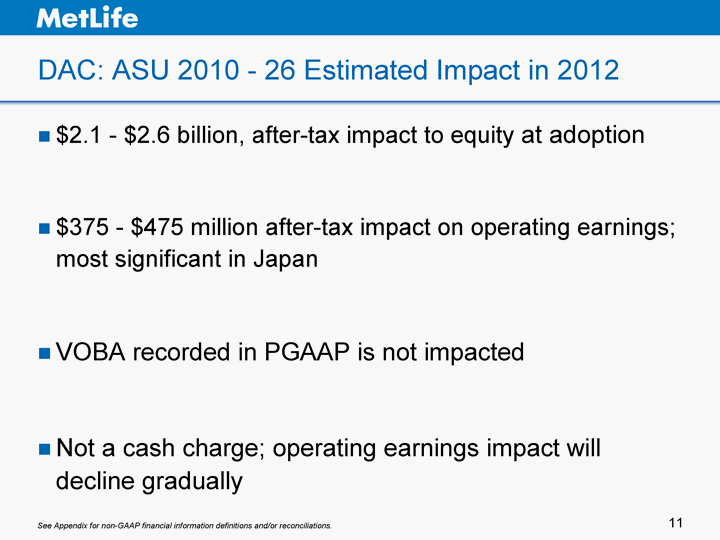
| 11 DAC: ASU 2010 - 26 Estimated Impact in 2012 $2.1 - $2.6 billion, after-tax impact to equity at adoption $375 - $475 million after-tax impact on operating earnings; most significant in Japan VOBA recorded in PGAAP is not impacted Not a cash charge; operating earnings impact will decline gradually 11 See Appendix for non-GAAP financial information definitions and/or reconciliations. |

| 12 2012 Plan ($ Millions, except per share data) See Appendix for non-GAAP financial information definitions and/or reconciliations. |
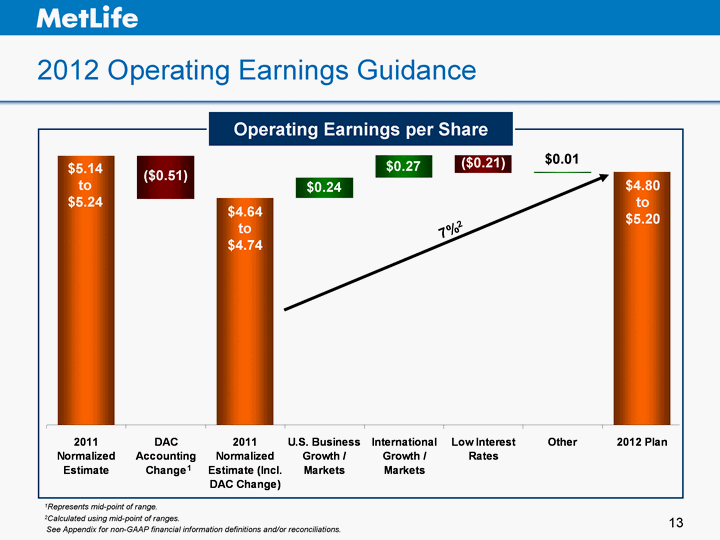
| 13 2012 Operating Earnings Guidance Operating Earnings per Share $4.64 to $4.74 $4.80 to $5.20 $0.24 $0.27 ($0.51) ($0.21) $5.14 to $5.24 7%2 1Represents mid-point of range. 2Calculated using mid-point of ranges. $0.01 See Appendix for non-GAAP financial information definitions and/or reconciliations. 1 |

| 14 2012 Premiums, Fees & Other Revenues Growth ($ Billions) 1Adjusted to represent the anticipated sale of MetLife Bank's forward mortgage and depository businesses. 2Calculated using mid-point of ranges before rounding. See Appendix for non-GAAP financial information definitions and/or reconciliations. |

| 15 2012 Operating Expense Ratio See Appendix for non-GAAP financial information definitions and/or reconciliations. Operating Expense Ratio 1Reflects the DAC accounting change. Expense discipline continues Maintaining focus on Alico integration Pension/PRB cost has a negative impact of $90 million 1 22.8% to 23.3% 23.3% to 23.6% 23.9% to 24.5% 24.3% to 24.6% |
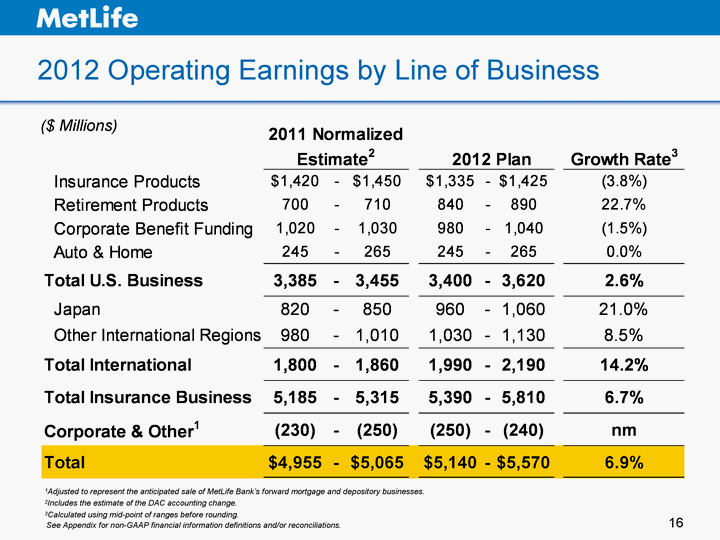
| 16 2012 Operating Earnings by Line of Business ($ Millions) 1Adjusted to represent the anticipated sale of MetLife Bank's forward mortgage and depository businesses. 2Includes the estimate of the DAC accounting change. 3Calculated using mid-point of ranges before rounding. See Appendix for non-GAAP financial information definitions and/or reconciliations. |

| 17 Financial Summary Despite macro headwinds, 2011 was a strong year with 10% year over year earnings growth Strong capital position and excess cash flow generation 2012: strong fundamentals drive earnings growth |
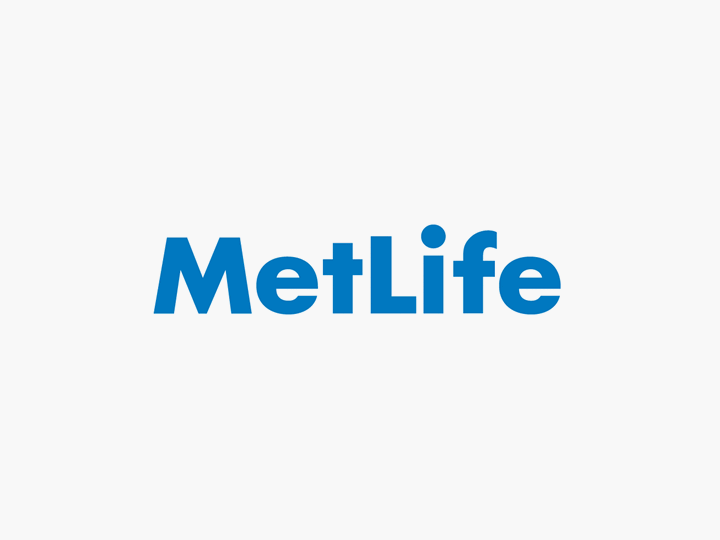

| INVESTOR PRESENTATION 2 0 1 1 Appendix |
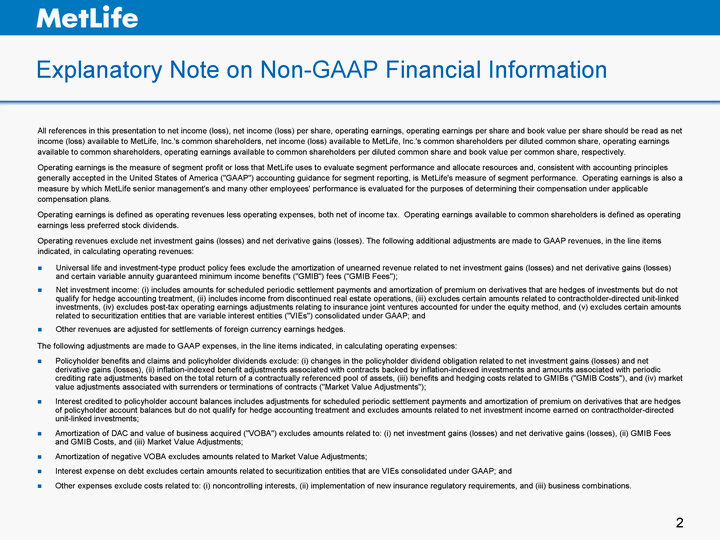
| Explanatory Note on Non-GAAP Financial Information All references in this presentation to net income (loss), net income (loss) per share, operating earnings, operating earnings per share and book value per share should be read as net income (loss) available to MetLife, Inc.'s common shareholders, net income (loss) available to MetLife, Inc.'s common shareholders per diluted common share, operating earnings available to common shareholders, operating earnings available to common shareholders per diluted common share and book value per common share, respectively. Operating earnings is the measure of segment profit or loss that MetLife uses to evaluate segment performance and allocate resources and, consistent with accounting principles generally accepted in the United States of America ("GAAP") accounting guidance for segment reporting, is MetLife's measure of segment performance. Operating earnings is also a measure by which MetLife senior management's and many other employees' performance is evaluated for the purposes of determining their compensation under applicable compensation plans. Operating earnings is defined as operating revenues less operating expenses, both net of income tax. Operating earnings available to common shareholders is defined as operating earnings less preferred stock dividends. Operating revenues exclude net investment gains (losses) and net derivative gains (losses). The following additional adjustments are made to GAAP revenues, in the line items indicated, in calculating operating revenues: Universal life and investment-type product policy fees exclude the amortization of unearned revenue related to net investment gains (losses) and net derivative gains (losses) and certain variable annuity guaranteed minimum income benefits ("GMIB") fees ("GMIB Fees"); Net investment income: (i) includes amounts for scheduled periodic settlement payments and amortization of premium on derivatives that are hedges of investments but do not qualify for hedge accounting treatment, (ii) includes income from discontinued real estate operations, (iii) excludes certain amounts related to contractholder-directed unit-linked investments, (iv) excludes post-tax operating earnings adjustments relating to insurance joint ventures accounted for under the equity method, and (v) excludes certain amounts related to securitization entities that are variable interest entities ("VIEs") consolidated under GAAP; and Other revenues are adjusted for settlements of foreign currency earnings hedges. 2 The following adjustments are made to GAAP expenses, in the line items indicated, in calculating operating expenses: Policyholder benefits and claims and policyholder dividends exclude: (i) changes in the policyholder dividend obligation related to net investment gains (losses) and net derivative gains (losses), (ii) inflation-indexed benefit adjustments associated with contracts backed by inflation-indexed investments and amounts associated with periodic crediting rate adjustments based on the total return of a contractually referenced pool of assets, (iii) benefits and hedging costs related to GMIBs ("GMIB Costs"), and (iv) market value adjustments associated with surrenders or terminations of contracts ("Market Value Adjustments"); Interest credited to policyholder account balances includes adjustments for scheduled periodic settlement payments and amortization of premium on derivatives that are hedges of policyholder account balances but do not qualify for hedge accounting treatment and excludes amounts related to net investment income earned on contractholder-directed unit-linked investments; Amortization of DAC and value of business acquired ("VOBA") excludes amounts related to: (i) net investment gains (losses) and net derivative gains (losses), (ii) GMIB Fees and GMIB Costs, and (iii) Market Value Adjustments; Amortization of negative VOBA excludes amounts related to Market Value Adjustments; Interest expense on debt excludes certain amounts related to securitization entities that are VIEs consolidated under GAAP; and Other expenses exclude costs related to: (i) noncontrolling interests, (ii) implementation of new insurance regulatory requirements, and (iii) business combinations. |
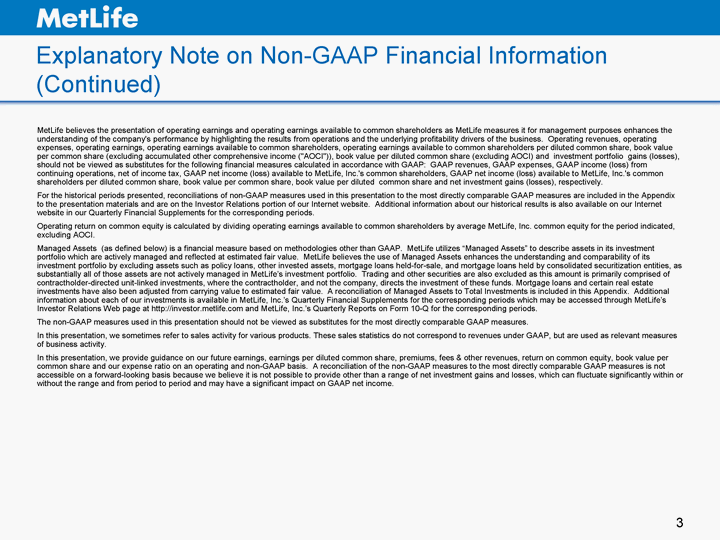
| Explanatory Note on Non-GAAP Financial Information (Continued) MetLife believes the presentation of operating earnings and operating earnings available to common shareholders as MetLife measures it for management purposes enhances the understanding of the company's performance by highlighting the results from operations and the underlying profitability drivers of the business. Operating revenues, operating expenses, operating earnings, operating earnings available to common shareholders, operating earnings available to common shareholders per diluted common share, book value per common share (excluding accumulated other comprehensive income ("AOCI")), book value per diluted common share (excluding AOCI) and investment portfolio gains (losses), should not be viewed as substitutes for the following financial measures calculated in accordance with GAAP: GAAP revenues, GAAP expenses, GAAP income (loss) from continuing operations, net of income tax, GAAP net income (loss) available to MetLife, Inc.'s common shareholders, GAAP net income (loss) available to MetLife, Inc.'s common shareholders per diluted common share, book value per common share, book value per diluted common share and net investment gains (losses), respectively. For the historical periods presented, reconciliations of non-GAAP measures used in this presentation to the most directly comparable GAAP measures are included in the Appendix to the presentation materials and are on the Investor Relations portion of our Internet website. Additional information about our historical results is also available on our Internet website in our Quarterly Financial Supplements for the corresponding periods. Operating return on common equity is calculated by dividing operating earnings available to common shareholders by average MetLife, Inc. common equity for the period indicated, excluding AOCI. Managed Assets (as defined below) is a financial measure based on methodologies other than GAAP. MetLife utilizes "Managed Assets" to describe assets in its investment portfolio which are actively managed and reflected at estimated fair value. MetLife believes the use of Managed Assets enhances the understanding and comparability of its investment portfolio by excluding assets such as policy loans, other invested assets, mortgage loans held-for-sale, and mortgage loans held by consolidated securitization entities, as substantially all of those assets are not actively managed in MetLife's investment portfolio. Trading and other securities are also excluded as this amount is primarily comprised of contractholder-directed unit-linked investments, where the contractholder, and not the company, directs the investment of these funds. Mortgage loans and certain real estate investments have also been adjusted from carrying value to estimated fair value. A reconciliation of Managed Assets to Total Investments is included in this Appendix. Additional information about each of our investments is available in MetLife, Inc.'s Quarterly Financial Supplements for the corresponding periods which may be accessed through MetLife's Investor Relations Web page at http://investor.metlife.com and MetLife, Inc.'s Quarterly Reports on Form 10-Q for the corresponding periods. The non-GAAP measures used in this presentation should not be viewed as substitutes for the most directly comparable GAAP measures. In this presentation, we sometimes refer to sales activity for various products. These sales statistics do not correspond to revenues under GAAP, but are used as relevant measures of business activity. In this presentation, we provide guidance on our future earnings, earnings per diluted common share, premiums, fees & other revenues, return on common equity, book value per common share and our expense ratio on an operating and non-GAAP basis. A reconciliation of the non-GAAP measures to the most directly comparable GAAP measures is not accessible on a forward-looking basis because we believe it is not possible to provide other than a range of net investment gains and losses, which can fluctuate significantly within or without the range and from period to period and may have a significant impact on GAAP net income. 3 |
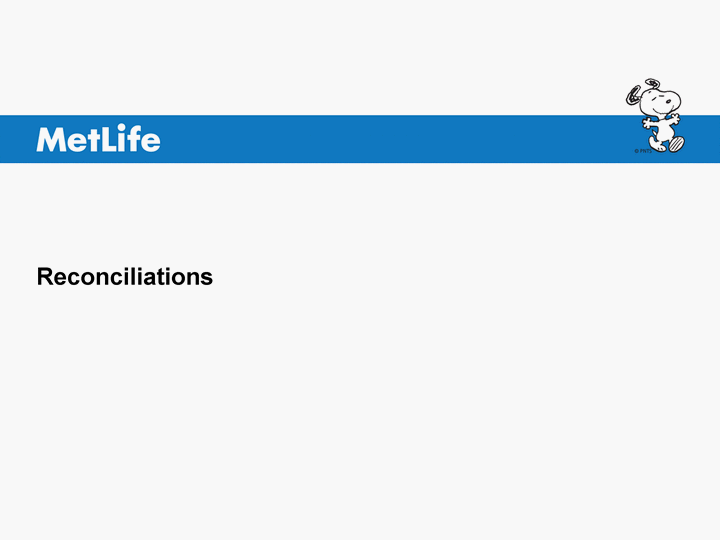
| Reconciliations |
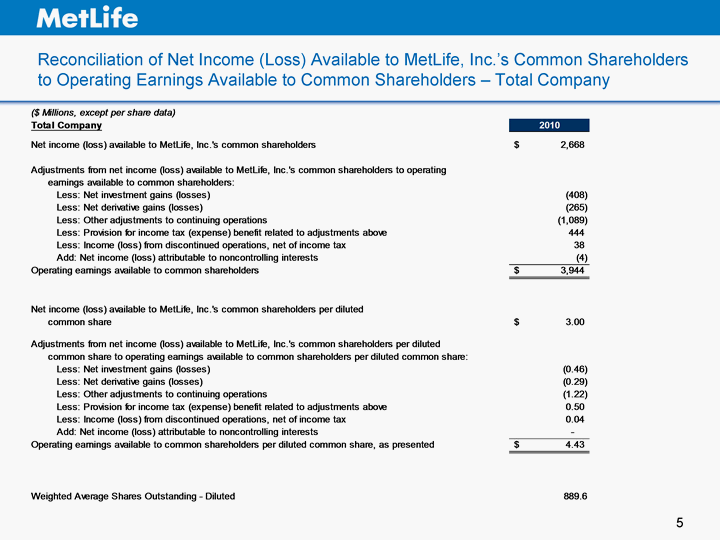
| 5 Reconciliation of Net Income (Loss) Available to MetLife, Inc.'s Common Shareholders to Operating Earnings Available to Common Shareholders - Total Company |

| 6 Reconciliation of Operating Expenses, Premiums, Fees & Other Revenues, and Operating Expense Ratio - Total Company |
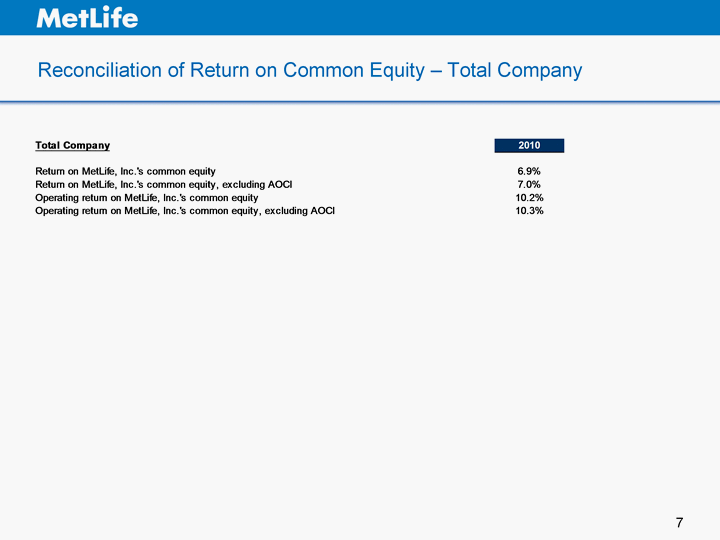
| 7 Reconciliation of Return on Common Equity - Total Company |
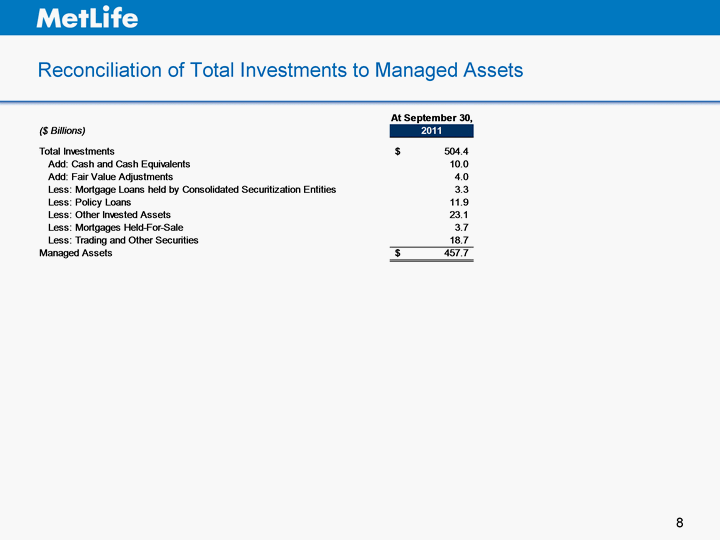
| 8 Reconciliation of Total Investments to Managed Assets |

| 9 Reconciliation of Net Investment Gains (Losses) to Investment Portfolio Gains (Losses) - Total Company |

| Outlook |
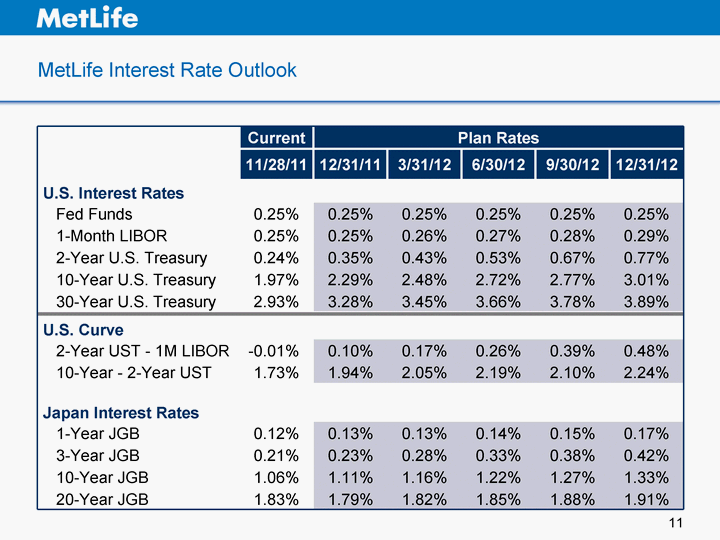
| 11 MetLife Interest Rate Outlook Current Plan Rates Plan Rates Plan Rates Plan Rates Plan Rates 11/28/11 12/31/11 3/31/12 6/30/12 9/30/12 12/31/12 U.S. Interest Rates U.S. Interest Rates U.S. Interest Rates U.S. Interest Rates Fed Funds Fed Funds Fed Funds 0.25% 0.25% 0.25% 0.25% 0.25% 0.25% 1-Month LIBOR 1-Month LIBOR 1-Month LIBOR 0.25% 0.25% 0.26% 0.27% 0.28% 0.29% 2-Year U.S. Treasury 2-Year U.S. Treasury 2-Year U.S. Treasury 0.24% 0.35% 0.43% 0.53% 0.67% 0.77% 10-Year U.S. Treasury 10-Year U.S. Treasury 10-Year U.S. Treasury 1.97% 2.29% 2.48% 2.72% 2.77% 3.01% 30-Year U.S. Treasury 30-Year U.S. Treasury 30-Year U.S. Treasury 2.93% 3.28% 3.45% 3.66% 3.78% 3.89% U.S. Curve U.S. Curve U.S. Curve U.S. Curve 2-Year UST - 1M LIBOR 2-Year UST - 1M LIBOR 2-Year UST - 1M LIBOR -0.01% 0.10% 0.17% 0.26% 0.39% 0.48% 10-Year - 2-Year UST 10-Year - 2-Year UST 10-Year - 2-Year UST 1.73% 1.94% 2.05% 2.19% 2.10% 2.24% Japan Interest Rates Japan Interest Rates Japan Interest Rates Japan Interest Rates 1-Year JGB 1-Year JGB 1-Year JGB 0.12% 0.13% 0.13% 0.14% 0.15% 0.17% 3-Year JGB 3-Year JGB 3-Year JGB 0.21% 0.23% 0.28% 0.33% 0.38% 0.42% 10-Year JGB 10-Year JGB 10-Year JGB 1.06% 1.11% 1.16% 1.22% 1.27% 1.33% 20-Year JGB 20-Year JGB 20-Year JGB 1.83% 1.79% 1.82% 1.85% 1.88% 1.91% |
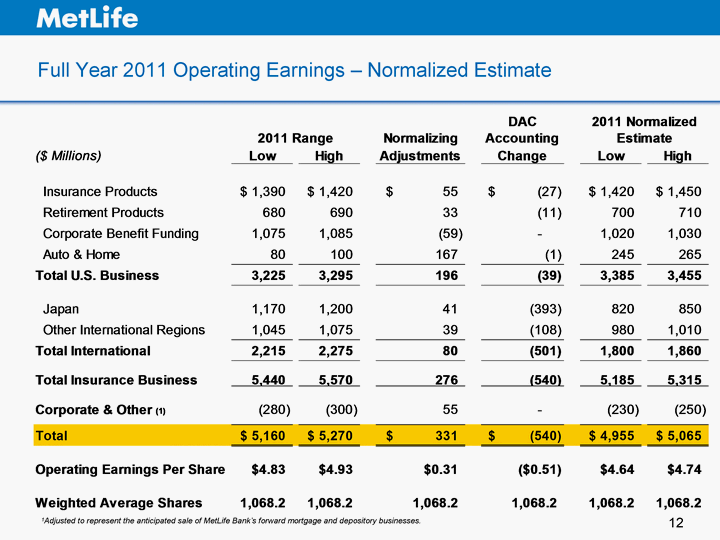
| Full Year 2011 Operating Earnings - Normalized Estimate 12 1Adjusted to represent the anticipated sale of MetLife Bank's forward mortgage and depository businesses. |
